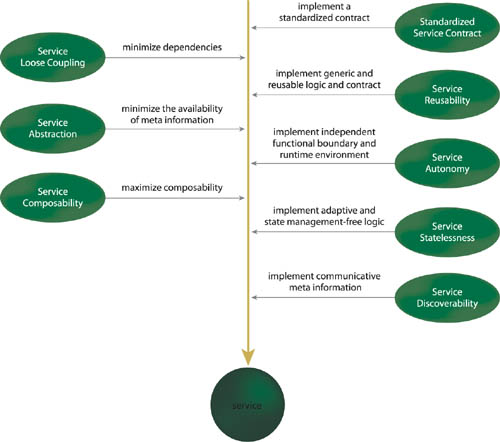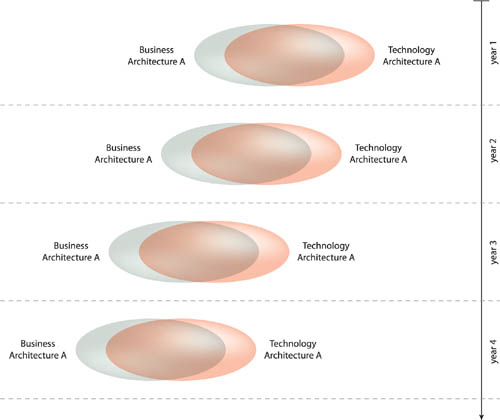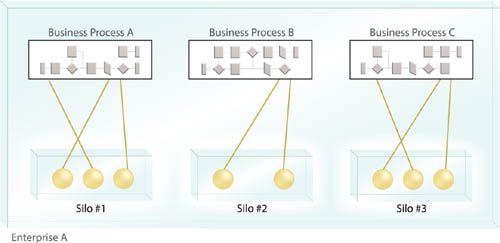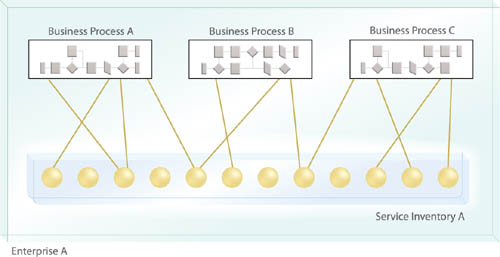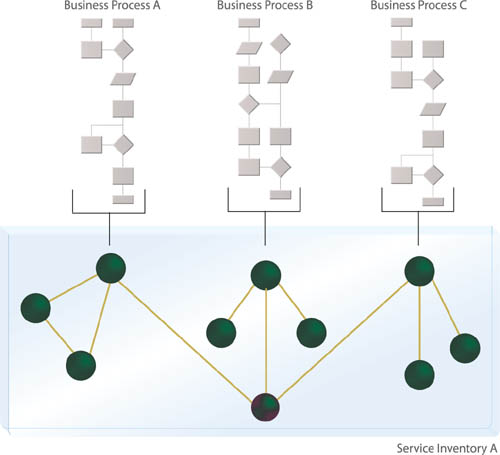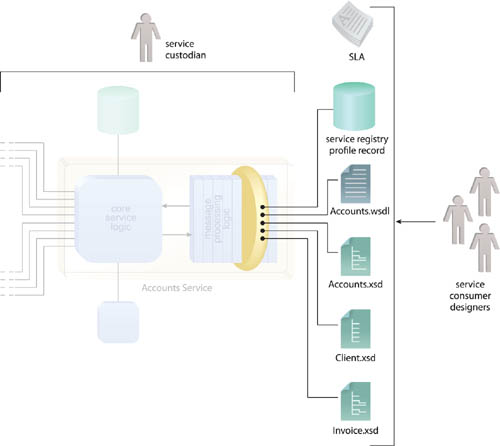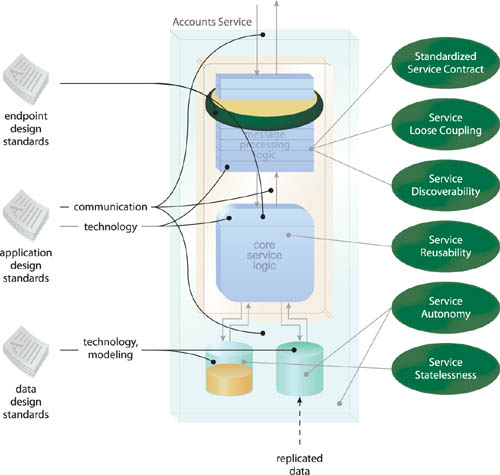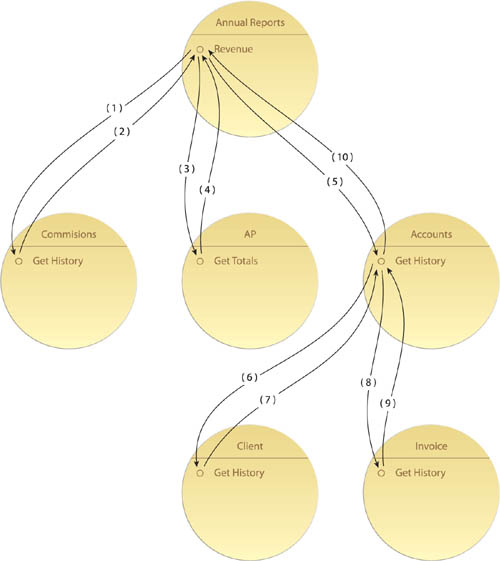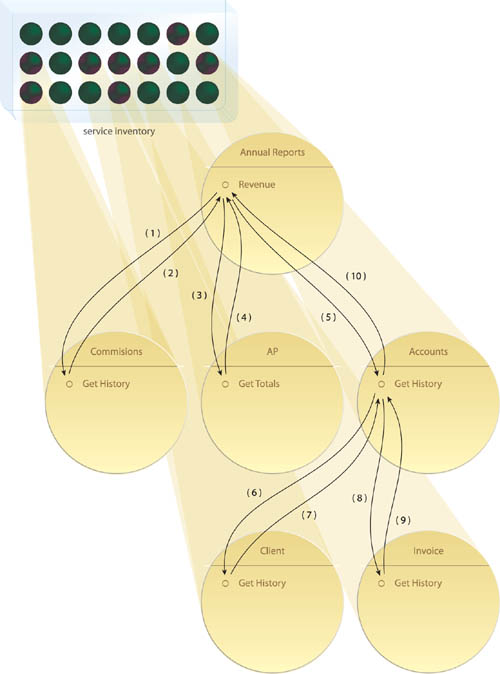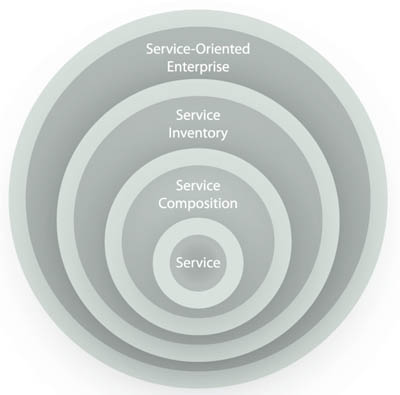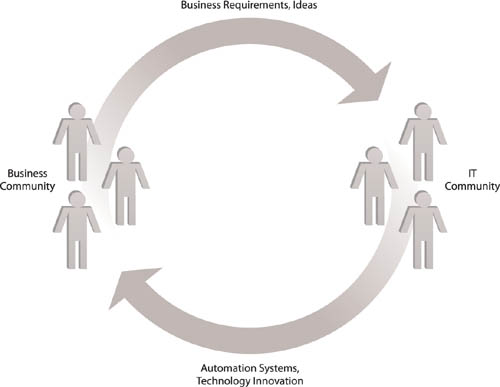
4.1 The Method of Service-Orientation
4.2 The Four Characteristics of SOA
4.3 The Four Common Types of SOA
4.4 The End Result of Service-Orientation
Service-oriented computing is fundamentally about attaining a specific target state. It asks that we take extra design considerations into account with everything we build so that all the moving parts of a service-oriented solution support the realization of this state and foster its growth and evolution. This target state is attractive because it has associated with it a specific set of goals and benefits.
To fully understand service-oriented technology architecture requires knowledge of:
• how these goals and benefits are achieved (the method)
• what entails the attainment of these goals and benefits (the end-result)
This understanding allows us to assess what requirements and demands are placed upon technology architecture.
The focus of this chapter is on establishing the relationship between service-orientation and service-oriented architecture by highlighting common architectural characteristics required to support the goals of service-orientation. This chapter furthermore documents types of service-oriented architecture that are referenced later in design pattern descriptions.
To realize the strategic benefits of service-oriented computing requires that each piece of solution logic be designed consistently and in a manner that fully supports the expected target environment. This is the role of service-orientation. It is the fundamental method by which service-oriented solutions are created.
There are eight distinct design principles that are part of the service-orientation design paradigm. Each addresses a key aspect of service design by ensuring that specific design characteristics are consistently realized within every service. When collectively applied to a meaningful extent, service-orientation design principles shape solution logic into something we can legitimately refer to as “service-oriented.”
Below are the eight service-orientation design principles together with their official definitions:
• Standardized Service Contract– Services within the same service inventory are in compliance with the same contract design standards.
• Service Loose Coupling– Service contracts impose low consumer coupling requirements and are themselves decoupled from their surrounding environment.
• Service Abstraction– Service contracts only contain essential information and information about services is limited to what is published in service contracts.
• Service Reusability– Services contain and express agnostic logic and can be positioned as reusable enterprise resources.
• Service Autonomy– Services exercise a high level of control over their underlying runtime execution environment.
• Service Statelessness– Services minimize resource consumption by deferring the management of state information when necessary.
• Service Discoverability– Services are supplemented with communicative meta data by which they can be effectively discovered and interpreted.
• Service Composability– Services are effective composition participants, regardless of the size and complexity of the composition.
Figure 4.1 provides some perspective as to how these principles affect the design of a service. The application of the principles on the right side tend to result in concrete design characteristics being added to a service, whereas the principles on the left usually act as regulatory influences, ensuring a balanced application of service-orientation as a whole.
As just mentioned, a solution is considered service-oriented once service-orientation has been applied to a meaningful extent. A mere understanding of the design paradigm, however, is insufficient. To apply service-orientation consistently and successfully requires a technology architecture customized to accommodate its design preferences, initially when services are first delivered and especially when collections of services are accumulated and assembled into complex compositions.
Note
Design principles are referenced throughout this book but represent a separate subject-matter that is covered in SOA Principles of Service Design. Introductory coverage of service-orientation is also available at SOAPrinciples.com.
Service-orientation emerged as a design approach in support of achieving the following goals and benefits associated with SOA and service-oriented computing:
• Increased Intrinsic Interoperability– Services within a given boundary are designed to be naturally compatible so that they can be effectively assembled and reconfigured in response to changing business requirements.
• Increased Federation– Services establish a uniform contract layer that hides underlying disparity, allowing them to be individually governed and evolved.
• Increased Vendor Diversification Options– A service-oriented environment is based on a vendor-neutral architectural model, allowing the organization to evolve the architecture in tandem with the business without being limited to proprietary vendor platform characteristics.
• Increased Business and Technology Domain Alignment– Some services are designed with a business-centric functional context, allowing them to mirror and evolve with the business of the organization.
• Increased ROI– Most services are delivered and viewed as IT assets that are expected to provide repeated value that surpasses the cost of delivery and ownership.
• Increased Organizational Agility– New and changing business requirements can be fulfilled more rapidly by establishing an environment in which solutions can be assembled or augmented with reduced effort by leveraging the reusability and native interoperability of existing services.
• Reduced IT Burden– The enterprise as a whole is streamlined as a result of the previously described goals and benefits, allowing IT itself to better support the organization by providing more value with less cost and less overall burden.
Note
Formal descriptions for these strategic goals are available at WhatIsSOA.com and in Chapter 3 of SOA Principles of Service Design.
When studying the design patterns in this book that support service-orientation, it is important to keep these goals (and the target state they represent) in mind. Understanding the ultimate state attainable provides us with a constant strategic context for each pattern. In other words, it helps provide insight into why certain parts of a service-oriented environment need to be designed in certain ways, which may not always be evident when reading through the pattern descriptions individually.
Having just explained the service-orientation design paradigm and its associated goals, we now need to turn our attention to the physical design of a service-oriented solution or environment.
In support of achieving the goals of service-orientation, there are four base characteristics we look to establish in any form of SOA:
• Business-Driven– The technology architecture is aligned with the current business architecture. This context is then constantly maintained so that the technology architecture evolves in tandem with the business over time.
• Vendor-Neutral– The architectural model is not based solely on a proprietary vendor platform, allowing different vendor technologies to be combined or replaced over time in order to maximize business requirements fulfillment on an on-going basis.
• Enterprise-Centric– The scope of the architecture represents a meaningful segment of the enterprise, allowing for the reuse and composition of services and enabling service-oriented solutions to span traditional application silos.
• Composition-Centric– The architecture inherently supports the mechanics of repeated service aggregation, allowing it to accommodate constant change via the agile assembly of service compositions.
These characteristics help distinguish SOA from other architectural models and also define the fundamental requirements a technology architecture must fulfill to be fully supportive of service-orientation. As we explore each individually, keep in mind that in real-world implementations the extent to which these characteristics can be attained tends to vary.
Traditional technology architectures were commonly designed in support of solutions delivered to fulfill tactical (short-term) business requirements. Because the overarching, strategic (long-term) business goals of the organization aren’t taken into consideration when the architecture is defined, this approach can result in a technical environment that, over time, becomes out of alignment with the organization’s business direction and requirements (Figure 4.2).
Figure 4.2 A traditional technology architecture (A) is often delivered in alignment with the current state of a business but can be incapable of changing in alignment with how the business evolves. As business and technology architectures become increasingly out of synch, business requirement fulfillment decreases, often to the point that a whole new technology architecture (B) is needed, which effectively resets this cycle.
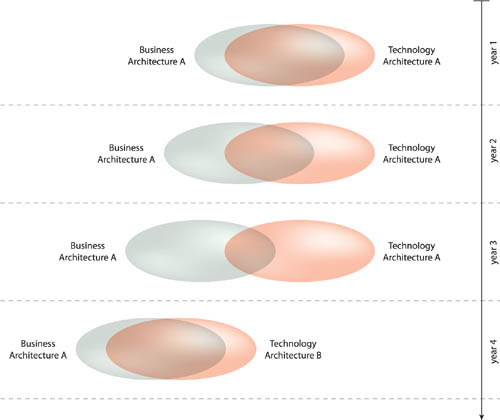
This gradual separation of business and technology results in a technology architecture with diminishing potential to fulfill business requirements and one that is increasingly difficult to adapt to changing business needs.
When a technology architecture is business-driven, the overarching business vision, goals, and requirements are positioned as the basis for and the primary influence of the architectural model. This maximizes the potential alignment of technology and business and allows for a technology architecture that can evolve in tandem with the organization as a whole (Figure 4.3). The result is a continual increase in the value and lifespan of the architecture.
Designing a service-oriented technology architecture around one particular vendor platform can lead to an implementation that inadvertently inherits proprietary characteristics. This can end up inhibiting the future evolution of an inventory architecture in response to technology innovations that become available from other vendors.
An inhibitive technology architecture is unable to evolve and expand in response to changing automation requirements, which can result in the architecture having a limited lifespan after which it needs to be replaced to remain effective (Figure 4.4).
Figure 4.4 Vendor-centric technology architectures are often bound to corresponding vendor platform roadmaps. This can reduce opportunities to leverage technology innovations provided by other vendor platforms and can result in the need to eventually replace the architecture entirely with a new vendor implementation (which starts the cycle over again).
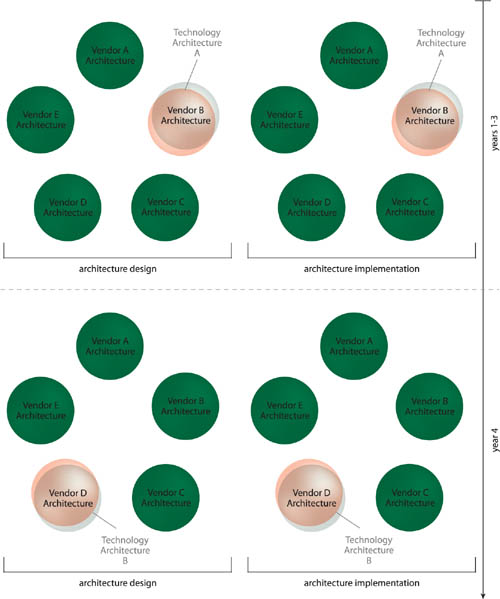
It is in the best interest of an organization to base the design of a service-oriented architecture on a model that is in alignment with the primary SOA vendor platforms, yet neutral to all of them. A vendor-neutral architectural model can be derived from a vendor-neutral design paradigm used to build the solution logic the architecture will be responsible for supporting. The service-orientation paradigm provides such an approach, in that it is derived from and applicable to real world technology platforms while remaining independent of them.
Note
Just because an architecture is classified as vendor-neutral doesn’t mean it is also aligned with current vendor technology. Some models produced by independent efforts are out of synch with the manner in which mainstream SOA technology exists today and is expected to evolve in the future and can therefore be just as inhibitive as vendor-specific models.
Figure 4.5 If the architectural model is designed to be and remain neutral to vendor platforms, it maintains the freedom to diversify its implementation by leveraging multiple vendor technology innovations. This increases the longevity of the architecture as it is allowed to augment and evolve in response to changing requirements.

Just because solutions are based on a distributed architecture doesn’t mean that there still isn’t the constant danger of creating new silos. In fact, it has been common to build distributed solutions comprised of single-purpose components. Software programs labeled as services that are designed in this manner naturally result in silos (Figure 4.6) that continue to bloat the enterprise and lead to traditional integration requirements.
When applying service-orientation, services are positioned as enterprise resources, which implies that service logic is designed with the following primary characteristics:
• The logic is available beyond a specific implementation boundary.
• The logic is designed according to established design principles and enterprise standards.
Essentially, the body of logic is classified as a resource of the enterprise. This does not necessarily make it an enterprise-wide resource or one that must be used throughout an entire technical environment. In other words, an enterprise resource does not belong solely to any one application or solution environment.
As further established in the pattern description for Service Encapsulation (305), an enterprise resource essentially embodies the fundamental characteristics of service logic.
Note
See the Enterprise vs. Enterprise-wide section in Chapter 5 for a comparison of how these two terms are used in this book.
In order to leverage services as enterprise resources, the underlying technology architecture must establish a model that is natively based on the assumption that software programs delivered as services will be shared by other parts of the enterprise or will be part of larger solutions that include shared services. This baseline requirement places an emphasis on standardizing parts of the architecture (as per the canonical patterns introduced in Chapter 5) so that service reuse and interoperability can be continually fostered (Figure 4.7).
More so than in previous distributed computing paradigms, service-orientation places an emphasis on designing software programs as not just reusable resources, but as flexible resources that can be plugged into different aggregate structures as part of a variety of service-oriented solutions.
To accomplish this, services must be composable. As advocated by the Service Composability principle, this means that services must be capable of being pulled into a variety of composition designs, regardless of whether they are initially required to participate in a composition when they are first delivered (Figure 4.8).
To support native composability, the underlying technology architecture must be prepared to enable a range of simple and complex composition designs. Architectural extensions (and related infrastructure extensions) pertaining to scalability, reliability, and runtime data exchange processing and integrity are essential to support this key characteristic.
Note
In the next section we introduce four specific types of service-oriented architecture. The aforementioned architectural characteristics are fundamental to all of these SOA types; however, it is worth singling out the service inventory as the primary starting point for their implementation. We revisit these four characteristics at the beginning of Chapter 6 to highlight how they relate to fundamental inventory patterns.
Summary of Key Points
• The four fundamental characteristics that any form of SOA needs to have in support of service-orientation are Business-Driven, Vendor-Neutral, Enterprise-Centric, and Composition-Centric.
• Whereas the Business-Driven and Vendor-Neutral characteristics help shape the overall context and model of a service-oriented architecture, the Enterprise-Centric and Composition-Centric characteristics place demands on the actual technology and infrastructure extensions that the architecture is based upon.
• The fundamental inventory patterns in Chapter 6 are closely related to these four characteristics.
As we’ve already established, every software program ends up being comprised of and residing in some form of architectural combination of resources, technologies, and platforms (infrastructure-related or otherwise). If we take the time to customize these architectural elements, we can establish a refined and standardized environment for the implementation of (also customized) software programs.
The intentional design of technology architecture is very important to service-oriented computing. It is essential to establishing an environment within which services can be repeatedly recomposed to maximize business requirements fulfillment. As evidenced by the range of architectural design patterns in this book, the strategic benefit to customizing the scope, context, and boundary of an architecture is significant.
To better understand the basic mechanics of SOA, we now need to study the common types of technology architectures that exist:
• Service Architecture– The architecture of a single service.
• Service Composition Architecture– The architecture of a set of services assembled into a service composition.
• Service Inventory Architecture– The architecture that supports a collection of related services that are independently standardized and governed.
• Service-Oriented Enterprise Architecture– The architecture of the enterprise itself, to whatever extent it is service-oriented.
Although they are roughly comparable to the four traditional architecture types described in the Architecture Fundamentals section in Chapter 3, each is distinct due to the unique requirements and dynamics of service-orientation (Figure 4.9). The next four sections explore these SOA types individually.
Figure 4.9 Services (top left) are delivered into a service inventory (right) from which service compositions (bottom left) are drawn. These basic elements establish the fundamental service-orientation dynamic but also represent the three common SOA types that can reside within a service-oriented enterprise (bottom).
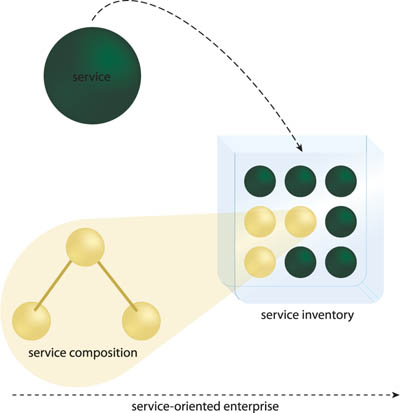
A technology architecture limited to the physical design of a software program designed as a service is referred to as the service architecture. This form of technology architecture is comparable in scope to a component architecture, except that it will typically rely on a greater amount of infrastructure extensions to support its need for increased reliability, performance, scalability, behavioral predictability, and especially its need for increased autonomy. The scope of a service architecture will also tend to be larger because a service can, among other things, encompass multiple components.
Whereas it was not always that common to document a separate architecture for a component in traditional distributed applications, the importance of producing services that need to exist as independent and highly self-sufficient and self-contained software programs requires that each be individually designed. Figure 4.10 shows a highly simplified view of a sample service architecture.
Figure 4.10 An example of a high-level service architecture view for the Accounts Web service, depicting the parts of the surrounding infrastructure utilized to fulfill the functional requirements of all capabilities (or operations). Additional views can be created to show only those architectural elements related to the processing of specific capabilities. Further detail, such as data flow and security requirements, would normally also be included.
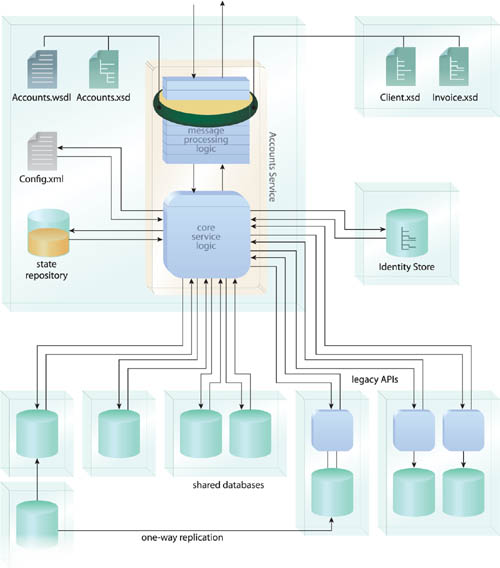
Service architecture specifications are typically owned by service custodians and, in support of the Service Abstraction design principle, their contents are often protected and hidden from other project team members (Figure 4.11).
The application of design standards and other service-orientation design principles (Figure 4.12) further affects the depth and detail to which a service’s technology architecture may need to be defined. For example, implementation consideration raised by the Service Autonomy and Service Statelessness principles can require a service architecture to extend deeply into its surrounding infrastructure by defining exactly what physical environment it is deployed within, what resources it needs to access, what other parts of the enterprise may be accessing those same resources, and what extensions from the infrastructure it can use to defer or store data it is responsible for processing.
A central part of a service architecture is typically its technical contract (Figure 4.13). Following standard service-oriented design processes, the service contract is usually the first part of a service to be physically delivered. The capabilities expressed by the contract further dictate the scope and nature of its underlying logic and the processing requirements that will need to be supported by its implementation.
Figure 4.13 The service contract is a fundamental part of the Accounts service architecture. Its definition gives the service a public identity and helps express its functional scope. Specifically, the WSDL document (A) expresses operations that correspond to segments of functionality (B) within the underlying Accounts service logic. The logic, in turn, accesses other resources in the enterprise to carry out those functions (C). To accomplish this, the WSDL document provides data exchange definitions via input and output message types established in separate XML Schema documents (D).
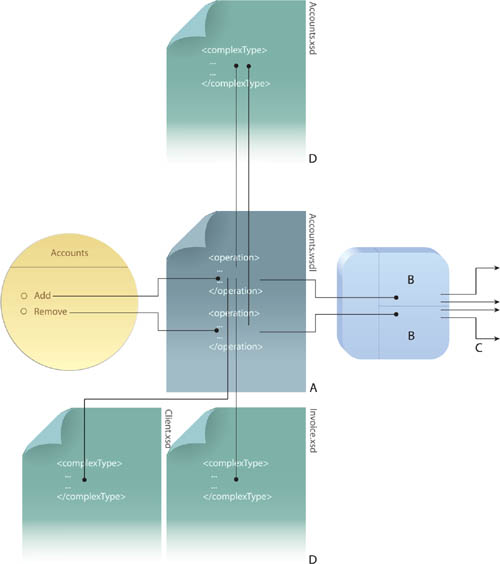
This is why some consideration is given to implementation during a service’s modeling phase (which occurs prior to its physical design).
Note
Many organizations use standard service profile documents to collect and maintain information about a service throughout its lifespan. Chapter 15 of SOA Principles of Service Design explains the service profile document and provides a sample template.
Another infrastructure-related aspect of service design is any dependencies the service may have on service agents—event-driven intermediary programs capable of transparently intercepting and processing messages sent to or from a service (Figure 4.14). Service agents can be custom-developed or may be provided by the underlying runtime environment, and they form the basis of a pattern appropriately titled Service Agent (543).
Within a service architecture the specific agent programs may be identified along with runtime information as to how message contents are processed or even altered by agent involvement. Service agents may themselves have their own architecture specifications that can be referenced by the service architecture.
A key consideration with any service architecture is the fact that the functionality offered by a service resides within one or more individual capabilities (Figure 4.15). This often requires the architecture definition itself to be taken to the capability level.
Each service capability encapsulates its own piece of logic, although the underlying logic may itself be modularized allowing different capabilities to share the same routines. Some of this logic may be custom-developed for the service, whereas other capabilities may represent or need to access one or more back-end resources (including other services). Therefore, individual capabilities end up with their own, individual designs that may need to be so detailed that they are documented as separate “capability architectures,” all of which relate back to the parent service architecture.
The fundamental purpose of delivering a series of independent services is so that they can be combined into service compositions—fully functional solutions capable of automating larger, more complex business tasks (Figure 4.16).
Each service composition has a corresponding service composition architecture. In much the same way an application architecture for a distributed system includes the individual architecture definitions of its components, this form of architecture encompasses the service architectures of all participating services (Figure 4.17).
Figure 4.17 The same Accounts service composition from Figure 4.16 viewed from a physical architecture perspective illustrating how each composition member’s underlying resources provide the functionality required to automate the process logic represented by the Accounts Add capability.
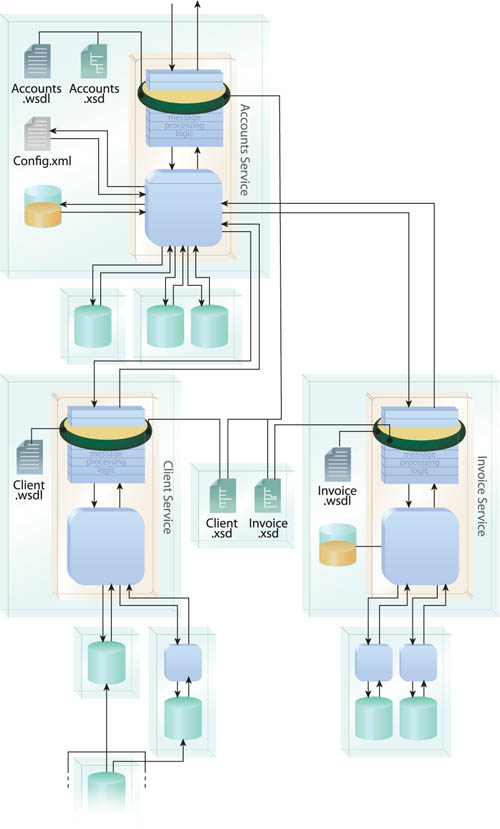
Note
Standard composition terminology defines two basic roles that services can assume within a composition. The service responsible for composing others takes on the role of composition controller, whereas composed services are referred to as composition members.
A composition architecture (especially one that composes services that encapsulate disparate legacy systems) may be compared to a traditional integration architecture. This comparison is usually only valid in scope, as the design considerations emphasized by service-orientation ensure that the design of a service composition is much different than that of integrated applications.
For example, one difference in how composition architectures are documented is in the extent of detail they include about reusable services involved in the composition. Because these types of service architecture specifications are often guarded (as per the requirements raised by the Service Abstraction principle), a composition architecture may only be able to make reference to the technical interface and service-level agreement (SLA) published as part of the service’s public contract (Figure 4.18).
Figure 4.18 The physical service architecture view from Figure 4.17 is not available to the designer of the Accounts service. Instead, only the information published in the contracts for the Invoice and Client services can be accessed and referenced in the Account service composition architecture.
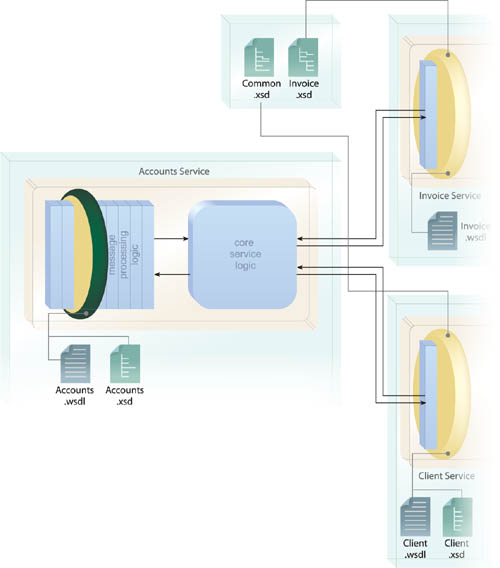
Note
Even though compositions are comprised of services, it is actually the service capabilities that are individually invoked and executed in order to carry out the composition logic. This is why design patterns, such as Capability Composition (521) and Capability Recomposition (526) make specific reference to the composed capability (as opposed to the composed service).
Another rather unique aspect of service composition architecture is that a composition may find itself a nested part of a larger parent composition, and therefore one composition architecture may encompass or reference another (Figure 4.19).
Service composition architectures are much more than just an accumulation of individual service architectures (or contracts). A newly created composition is usually accompanied by a task-specific service that is positioned as the composition controller. The details of this service are less private, and its design is an integral part of the architecture because it usually provides most of the composition logic required.
Furthermore, the business process the service is required to automate may involve the need for composition logic capable of dealing with multiple runtime scenarios (exception-related or otherwise), each of which may result in a different composition configuration (Figure 4.20). These scenarios and their related service activities and message paths are a common part of composition designs. They need to be understood and mapped out in advance so that the composition logic encapsulated by the task service is fully prepared to deal with the range of runtime situations it faces.
Figure 4.20 A given business process may need to be automated by a range of service compositions in order to accommodate different runtime scenarios. In this case, alternative composition logic within the Annual Report’s Revenue capability kicks in to deal with an exception condition. As a result, the Notification service is invoked prior to the Accounts service even being included in the composition. (This scenario represents an alternative composition design to the one shown in Figure 4.19.)
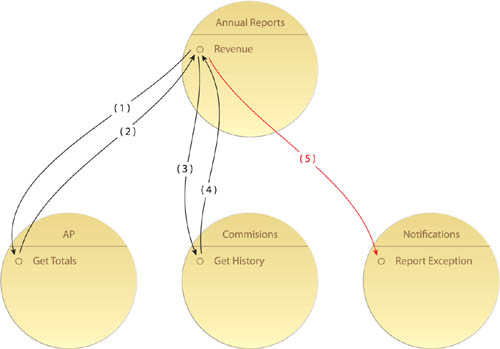
A composition architecture will be heavily dependent on the activity management features of the underlying runtime environment responsible for hosting the services participating in the composition. Security, transaction management, reliable messaging, and other infrastructure extensions, such as support for sophisticated message routing, may all find their way into a typical composition architecture specification. Numerous patterns in this book address these types of extensions.
Note
It’s often difficult to determine where a service architecture ends and where a composition architecture begins. One service can compose others, which can make a given composition architecture seem like an extension of a service architecture. Often these lines are drawn when the Service Abstraction principle is applied, thereby defining clean boundaries around service architectures that are hidden from the overall composition design.
Services delivered independently or as part of compositions by different IT projects risk introducing redundancy and non-standardization. This can lead to a non-federated enterprise in which clusters of services mimic an environment comprised of traditional siloed applications.
The result is that though often classified as a service-oriented architecture, many of the traditional challenges associated with design disparity, transformation, and integration continue to emerge and undermine strategic service-oriented computing goals.
As first explained in Chapter 3, a service inventory is a collection of independently standardized and governed services delivered within a pre-defined architectural boundary. This collection represents a meaningful scope that exceeds the processing boundary of a single business process and ideally spans numerous business processes. The scope and boundary of a service inventory architecture can vary, as explained in the Enterprise Inventory (116) and Domain Inventory (123) pattern descriptions.
Ideally, the service inventory is first conceptually modeled, leading to the creation of a service inventory blueprint. It is often this blueprint that ends up defining the required scope of the architecture type referred to as a service inventory architecture (Figure 4.21).
From an enterprise design perspective, the service inventory can represent a concrete boundary for a standardized architecture implementation. This means that because the services within an inventory are standardized, so are the technologies and extensions provided by the underlying architecture.
As evidenced by the inventory boundary design patterns in Chapter 6, the scope of a service inventory can be enterprise-wide, or it can represent a domain within the enterprise. For that reason, this type of architecture is not called a “domain architecture.” It relates to the scope of the inventory boundary, which may encompass multiple domains.
Note
When the term “SOA” or “SOA implementation” is used, it is most commonly associated with the scope of a service inventory. In fact, with the exception of some design patterns that address cross-inventory exchanges, most of the patterns in this book are expected to be applied within the boundary of a service inventory.
It is difficult to compare a service inventory architecture with traditional types of architecture because the concept of an inventory has not been common. The closest candidate would be an integration architecture that represents some significant segment of an enterprise. However, this comparison would be only relevant in scope, as service-orientation design characteristics and related standardization efforts strive to turn a service inventory into a highly homogenous environment.
Note
For more information about how service-orientation differs from and attempts to address the primary challenges associated with silo-based, standalone application environments, see SOAPrinciples.com. To learn more about defining service inventory blueprints, visit SOAMethodology.com.
This form of technology architecture essentially represents all service, service composition, and service inventory architectures that reside within a specific IT enterprise.
A service-oriented enterprise architecture is comparable to a traditional enterprise technical architecture only when most or all of an enterprise’s technical environments are service-oriented. Otherwise it may simply be a documentation of the parts of the enterprise that have adopted SOA, in which case it exists as a subset of the parent enterprise technology architecture.
In multi-inventory environments or in environments where standardization efforts were not fully successful, a service-oriented enterprise architecture specification will further document any transformation points and design disparity that may also exist.
Additionally, the service-oriented enterprise architecture can further establish enterprise-wide design standards and conventions to which all service, composition, and inventory architecture implementations need to comply, and which may also need to be referenced in the corresponding architecture specifications. (Canonical Resources (237) represents a pattern that may introduce such standards.)
Figure 4.22 illustrates how each of the previously described service-oriented architecture types establishes its own scope. Service architectures fall within composition architectures and both are natural parts of a service inventory architecture. The service-oriented enterprise architecture represents a parent architecture that encompasses all others.
The environment and conventions established by the enterprise are carried over into individual service inventory architecture implementations that may reside within a single enterprise environment. These inventories further introduce new and more specific architectural elements (such as runtime platforms and middleware) that then form the foundation of service and composition architectures implemented within the inventory boundary.
As a result, a natural form of architectural inheritance is formed. This relationship between architecture types is good to keep in mind as it can identify potential (positive and negative) dependencies that may exist.
All of the architecture types explored so far relate mostly to a private IT enterprise environment. While these represent the most common variations, they are by no means the only ones. The following two sections discuss some examples of additional architecture types with different scopes and characteristics.
This is an architecture that spans enterprises and therefore is prone to encompass diverse environments and incompatible design conventions. A focal point is often the use of transformation technologies, security, and access to subsets of inventory logic.
Note that an inter-business service architecture is different from a traditional B2B environment. Data exchange is designed around communication across partner service inventories via predefined service endpoints and can include specialized compositions that also span inventories.
With the advent of community-centric data exchange standards, such as the Web Services Choreography Description Language (WS-CDL) and a growing marketplace of third-party services, the option is there to define a service-oriented architecture dedicated to collaboration among community members.
Note
Patterns, such as Service Perimeter Guard (394), Inventory Endpoint (260), and many of the security patterns in Chapters 13 and 20, are often used to support this SOA type.
Additional variations of service-oriented architecture can exist. For example, hybrid architectures comprised of a combination of traditional and service-oriented elements may be created as a result of pilot or partially completed transition projects, or they may exist as an intermediate architecture while a larger-scale migration is still underway.
Summary of Key Points
• A service architecture represents the technology architecture that pertains to a service and any of the enterprise resources its capabilities may need to access or rely upon.
• A service composition architecture corresponds to a service composition and therefore encompasses the individual architectures of its member services as well as any additional architectural elements that may be required to carry out the composition logic.
• A service inventory architecture typically represents a significant scope that encompasses all service and composition architectures related to the boundary of a pre-defined service inventory.
• A service-oriented enterprise architecture represents all service inventories within an enterprise and further defines cross-inventory communication options and enterprise design standards.
Automated business communities and the IT industry have an endless bi-directional relationship where each influences the other. Business demands and trends create automation requirements that the IT community strives to fulfill. New method and technology innovations produced by the IT community help inspire organizations to improve their existing business and even try out new lines of business. (The advent of the Internet is a good example of the latter.)
The IT industry has been through the cycle depicted in Figure 4.23 many times. Each iteration has brought about change and generally an increase in the sophistication and complexity of technology platforms.
Sometimes a series of iterations through this progress cycle leads to a foundational shift in the overall approach to automation and computing itself. The emergence of major platforms and frameworks, such as object-orientation and enterprise application integration, are examples of this. Significant changes like these represent an accumulation of technologies and methods and can therefore be considered landmarks in the evolution of IT itself. Each also results in the formation of distinct technology architecture requirements.
Service-oriented computing is no exception. The platform it establishes provides the potential to achieve significant strategic benefits that are a reflection of what business communities are currently demanding, as represented by the following previously described goals:
• Increased Intrinsic Interoperability
• Increased Federation
• Increased Vendor Diversification Options
• Increased Business and Technology Domain Alignment
• Increased ROI
• Increased Organizational Agility
• Reduced IT Burden
It is the target state resulting from the attainment of these strategic goals that an adoption of service-orientation attempts to achieve. In other words, these goals represent the desired end-result of applying the method of service-orientation.
How then does this relate to service-oriented technology architecture? Figure 4.24 hints at how the pursuit of these specific goals results in a series of impacts onto all architecture types brought upon by the application of service-orientation.
Figure 4.24 The common strategic goals and benefits of service-oriented computing are realized through the application of service-orientation. This, in turn, impacts the demands and requirements placed upon the four types of service-oriented technology architectures. (Note that the three goals on the right [green] represent the ultimate target benefits achieved when attaining the four goals on the left [gray].)
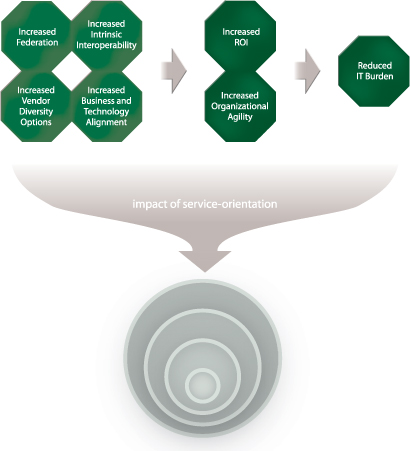
Note
For those of you interested in how each of the strategic goals relates to specific design patterns, see Chapter 23.
Almost all of the design patterns in this book are specifically intended to support the application of service-orientation by solving common problems that may arise as a result of the impact placed upon the different architecture types. This is an important perspective to keep in mind when working with SOA design patterns, as it is always helpful to understand that all patterns in this catalog share this common objective.
Ultimately, the successful implementation of service-oriented architectures will support and maintain the benefits associated with the strategic goals of service-oriented computing. As concluded by Figure 4.25, the progress cycle that continually transpires between business and IT communities results in constant change. Standardized, optimized, and overall robust service-oriented architectures fully support and even enable the accommodation of this change as a natural characteristic of a service-oriented enterprise.

